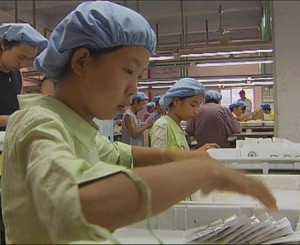 Technology makes our lives easier. But the world we live in has hidden corners where others suffer for our easy life. They are exploited, poisoned then buried under mountains of technology trash. These people are resigned to accept it as the way life is. This is the dirt and blood that coats the billions of dollars made manufacturing, selling and disposing of technology. In this series the African-American Cyber Report will expose the dirty secrets of the technology industry. In the second article of this series we examine the practice of child and forced labor.
Technology makes our lives easier. But the world we live in has hidden corners where others suffer for our easy life. They are exploited, poisoned then buried under mountains of technology trash. These people are resigned to accept it as the way life is. This is the dirt and blood that coats the billions of dollars made manufacturing, selling and disposing of technology. In this series the African-American Cyber Report will expose the dirty secrets of the technology industry. In the second article of this series we examine the practice of child and forced labor.
In the previous report we wrote about the use of conflict minerals and the conditions of the mines where these minerals come from. We also pointed out that many children work in these mines.
The definition of child labor according to Australian based WorldVision Action report is “work that deprives children of their childhood, their potential and their dignity. Work that exceeds a minimum number of hours; work that is mentally, physically, socially or morally dangerous and harmful to children; and work that interferes with their schooling.”
The worlds largest phone and technology companies, Apple, Samsung and Microsoft, along with a list of others are being accused by Amnesty International of failing to perform even the most minor checks to ensure the minerals they use in their products are not mined by children.
According to report from United Nations Children’s Emergency Fund (UNICEF) estimates that there are approximately 40,000 children are working in mines in the Congo alone. In these mines children, sometimes along side their parents, work with their bare hands to dig out minerals used in our modern electronics. Theses mines are extremely dangerous and little of no safety equipment is provided. Children breath toxic dust and risk injury and death deep inside mineral mines. In a quote from a 2012 report “Jean-Bertin, a 34-year-old Congolese activist said he wants to end the “absolute silence” around the crimes committed in his country to exploit strategic raw materials like coltan. “It’s possible that two children died so that you could have that mobile phone,” he said
Yet major technology companies continue to buy these minerals from what is essentially slave labor providers sometime denying any knowledge of child forced labor.
An investigation by Amnesty International looked in to the business of Chinese Mineral giant Zhejiang Huayou Cobalt Ltd. The company is major supplier of mineral to technology companies.
According to a BBC report Amnesty contacted 16 multinational battery manufacturers that purchased minerals from companies who in turn source minerals from Huayou Cobalt.
One company admitted to buying the mineral while four others were uncertain of source of the cobalt they used. Five others denied sourcing the mineral from the company even though company documents listed them as customers. Six other companies said they were investigating the claims.
But the issues of child and forced labor goes well beyond the African continent and the mining industry. In Asia many companies use indentured workers, forced child labor and even kidnappings in the manufacture of electronics.
According to the World Vision Action Report China is the producer of almost half world’s electronics products. It is also where worker exploitation has been widely reported. Workers in these Chinese electronics factories receive low wages and are forced to work excessive overtime to meet astronomical production goals. Some factories fail to offer employees protective clothing and equipment. The result is that workers are exposed to hazardous chemicals and odors. Other common complaints include discrimination, verbal harassment and excessive punishment from factory management.
Even in this sector of the electronics industry child labor is still an issue. Cases have been reported where children as young as nine years old have been found working in factories making electronics. Due to a labor shortages in China children from poor, rural areas are recruited to work in factories. Recruiters sometimes send money to the child’s family on a monthly basis as an incentive to keep their child working.
Some children are kidnapped and forced to work in the factories. Children are transported to cities and factories where kidnappers deal with factory owners to supply child labor and offer to attend the factories to beat the children if they are disobedient. These children are threatened and beaten to prevent them from running away and work up to 12 hours a day with no idea or hope of ever seeing their home or parents again.
World Vision Action also reported that children being forced out of school to work as “student interns” or “apprentices” in factories to pay off debts, tuition and school fees. These are the factories making our smartphones and tablets. Should a student desire to quit and return to their family, school administrators threaten to fail them. Other measures used to coerce students to stay in the factory include factory management withholding wages or confiscating identity papers if they attempt to leave.
What has the manufacturers said about this situation. Read their statements to TechCrunch.com here.
Now you know
